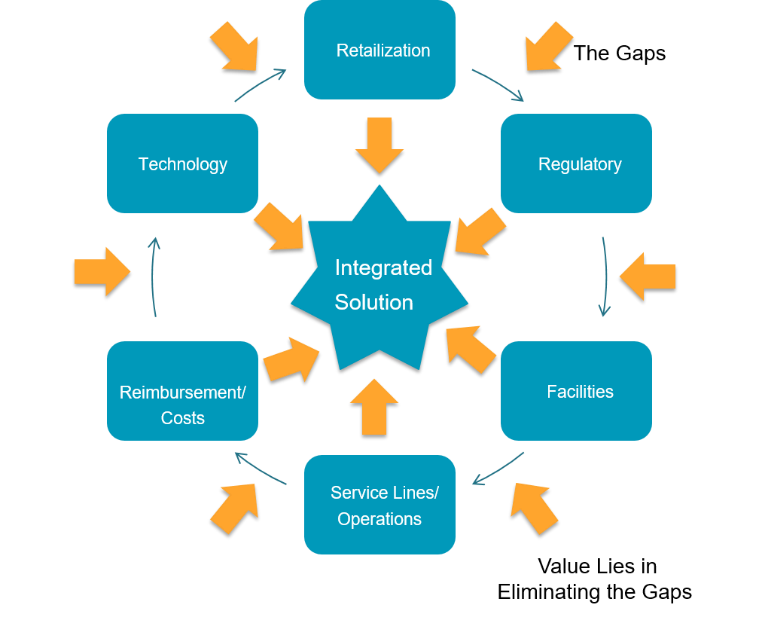As the delivery of healthcare services continues to evolve toward greater efficiency, so too must the clinics, medical centers and hospitals we all count on for care.
Yet healthcare organizations looking to expand or build new facilities face a complex array of challenges including increasing patient choices and expectations, high-deductible health plans, changing payor demands, the game-changing impact of new technology, industry consolidation, new compensation models, a higher number of employed physicians, and a new political climate. The quest for value over volume in healthcare, together with the emphasis on quality, requires new ways to deliver services—and to develop facilities that support these initiatives.
How can you plan for a facility that addresses the changing marketplace and makes the most of your capital investment? By taking an integrated approach early in the project, during the planning stage.
An integrated planning approach is key to increasing efficiency, advancing quality of care, and improving satisfaction among patients and staff. It can strengthen your organization's brand by creating environments and experiences that bring the brand to life for patients and staff. And it can build greater value into every square foot, transforming departmentalized points of view into holistic solutions that deliver higher return on investment.
An integrated approach calls for an integrated planning team—one that closes the gaps between the many diverse areas of focus across the organization. Typically, healthcare staff are accustomed to taking a more siloed approach to facility planning, tasked to meet mandates that cover their own department's facility requirements. At most, they may be asked to consider their role in a larger system—from their point of view. Such limited interaction among key stakeholder groups is not enough to develop a fully integrated solution for a facility.
Healthcare organizations need to create planning teams that engage key stakeholders across the organization—including administration, finance, facilities, clinical delivery, technology and regulatory compliance. It's important to form the team early in the planning process, before assumptions are made and "the first and/or loudest voice" begins to dominate the conversation.

Figure 1 illustrates an integrating planning team.
Leading teams to true integration
In addition to having the right people on board, success depends on creating an environment in which all voices can be heard, priorities established together, and options openly evaluated.
For instance, when confronting a need that would normally result in a facility modification, addition or new construction, determining the right scope can only happen when everyone on the team is present to weigh in. A skilled facilitator can lead the team through these important conversations, bringing the objectivity to identify competing and compatible issues, and helping members understand each others' points of view. It is possible that through this integrated approach the capital expense can be avoided through increased efficiencies, changes in clinical process or other non-construction related modifications.
An impartial facilitator can also help the team avoid ending its conservations at the first question—which is usually the most obvious one. Only by considering all points of view can you get to the right questions and arrive at the right answers. The experience of mutual inquiry can open minds and possibilities, leading to areas of consensus that serve the best interests of the enterprise.
An integrated approach to facility planning is foundational to achieving higher quality and efficiency by design. For example, with all key stakeholders engaged in an integrated planning approach from the start, you might:
• Find ways that technology can markedly improve the entire patient experience, from streamlining check-in and reducing waiting-room times to improving follow-up.
• Create more level scheduling among key clinical spaces, which may allow you to reduce the size and expense of waiting rooms required.
• Plan the facility for a lifetime of adaptability. Integrated planning can lead to exam rooms that work for multiple specialties, with the flexibility to be reconfigured quickly and easily as needs change over time.
Taking an integrated approach to facility planning has always made sense, but the evolving nature of healthcare delivery models and technologies makes it more important than ever. Where siloed thinking ends, real synergies can begin. The power of bringing an integrated approach into the planning stage is that you can build on its full value for the life of your facility.
About the Author
David Derr is a Principal with Point B Property Development. For more than 40 years, David has been involved with the programming, planning, design and construction of healthcare facilities in the US, Europe and the Middle East. Over his career David has worked on healthcare projects totaling over 10 million square feet with a construction value in excess of $2 billion. He started his career in Washington, DC as a technical architect. Upon becoming a project manager, he directed the University of Virginia Medical Center team on the full build-out of nearly 1,000,000 square feet. That was followed by international projects in Germany, the United Kingdom, Saudi Arabia, Dubai and Bahrain along with domestic projects for Sutter Health, Kaiser Permanente, Banner Health, and Group Health Cooperative, which further helped inform his thinking about what constitutes a successful healthcare project.
The views, opinions and positions expressed within these guest posts are those of the author alone and do not represent those of Becker's Hospital Review/Becker's Healthcare. The accuracy, completeness and validity of any statements made within this article are not guaranteed. We accept no liability for any errors, omissions or representations. The copyright of this content belongs to the author and any liability with regards to infringement of intellectual property rights remains with them.